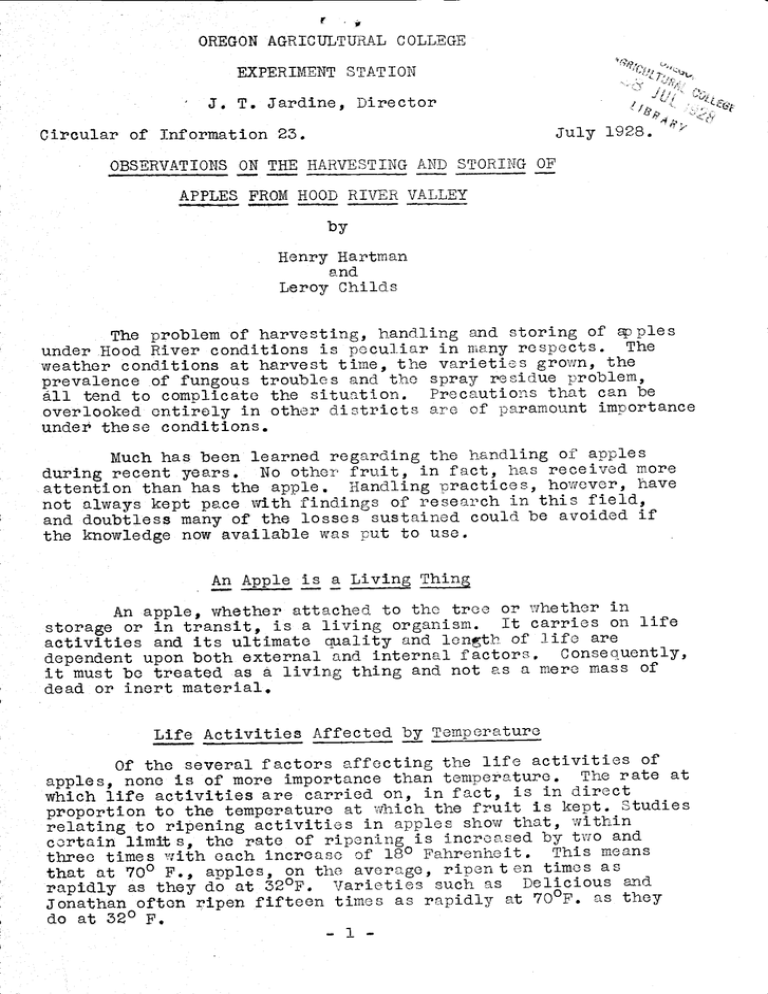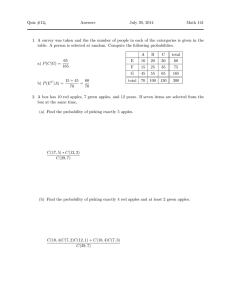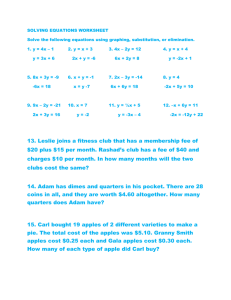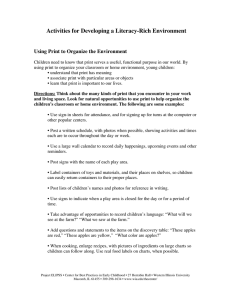I
advertisement

I OREGON AGRICULTURAL COLLEGE EXPERIMENT STATION 3. T. Jardine, Director Oicular of Information 23. OBSERVATIONS ON THE HARVESTING AND STORING OF APPLES FROM HOOD RIVER VALLEY by Henry Hartman and Leroy Childs ples The problem of harvesting, handling and storing of under Hood River conditions is peculiar in many respects. The weather conditions at harvest time, the varieties grown, the prevalence of fungous troubles and the spray residue problem, all tend to complicate the situation. Precautions that can be overlooked entirely in other districts are of paramount importance undei these conditions. Much has been learned regarding the handling of apples during recent years. No other fruit, in fact, has received more attention than has the apple. Handling practices, however, have not always kept pace with findings of research in this field, and doubtless many of the losses sustained could be avoided if the knowledge now available was put to use. An Apple is a Living Thins An apple, whether attached to the tree or whether in storage or in transit, is a living organism. It carries on life activities and its ultimate ciality and lonth of life are Consequently, dependent upon both external and internal factors. it must be treated as a living thing and not as a mere mass of dead or inert material. Life Activities Affected by Temperature Of the several factors affecting the life activities of apples, none is of more importance than temperature. The rate at which life activities are carried on, in fact, is in direct proportion to the temperature at which the fruit is kept. Studies relating to ripening activities in apples show that, within certain limit s, the rate of ripening is increased by two and three times with each increase of 180 Fahrenheit. This means that at 700 F., apples, on the average, ripen ten times as rapidly as they do at 32°F. Varieties such as Delicious end Jonathan often ripen fifteen times as rapidly at 70°F. as they do at 32 F. -1- The significance of those figures is at once apparent. Apples left under the trees or in packing sheds deteriorate as much in one day as they do in ten to fifteen days in cold storage. The idea that apples are safe so long as they are picked and in boxes is doubtless responsible for much of the spoilage that occurs in the handling df apples. Apples ripen faster after picking than they do before picking at the same temperatures. This mean that apples left in boxes in the orchard ripen at a more rapid rate than those attached to the tree. Apples held in cold storage, however, ripen much slower than either those left on the trees or those left in boxes outside. Too Many Overripe Apples here is but little doubt that the apple has lost in popularity in recent years because the markets have been filled \Jith overripe apples. The consuming public coon tires of fruit that has lost its flavor and juiciness. The Hood River district has spent large sums of money in the construction of cold No other district, in fact, has better storage storage plants. however, if facilities. The value of this investment is alloiod to live its because of delays in handling, the fruit i natural storage life before refrigeration is applied. lost, Climatic Conditions The cj4mate of the Hood Rivur Valley during the harvesting season is not ideal fQr the handling of apples. Cool nights are rare, the day temperatures are ftequcntly high, and the air is. usually humid. These conditions bring on cick ripening and foster the development of decay organisms. Deleterious effects from such con.itions can only be overcome by prompt and efficient handling. Storage Temperatures to a minimum The rate of ripening in apples can be reduced It is impossible, however, to stop by cold temperatures. completely the ripening process "ithout injury to the fruit. It Is generally recognized that 30° to 32° F. are desirable temperatures for the long keeping of ariples, Recent studies have shown, howevor, that storage rooms held at 300 F. are from per cent more efficient than those held at 32° F. 16 to Storage Humidities Apples in storage lose weight excessively unless they are kept at fairly high humidities, Losses in weight ranging from riod unless six to twelve per cent may occur durin the storage the humidity factor receives attention. This is oscially true of such varieties as Spitzenburg, Golden Delicious, end Jonathan. -2- Relative humidities varying between 80 and 85 per cent arc uswlly sufficient to prevent ocossive loss of weight Time of Picking Casual observations as well as experimental evidence have emphasized the fact that the degree of maturity attained at picking time exerts a pronounced influence upon the dessert and keeping quality of apples. When picked prematurely, apples &re often undersized, and may wilt considerably in storage. They lack in flavor and may be tough in texture. Frequently they are susceptible to storage scald. When picked too late, on the other htid, apples are usually short lived. They become dry and mealy very aulckly and are especially susceptible to decay and to certain physiological troubles. Color in Relation to Maturity is not Apparently the rod or over-color in applo definitely related to maturity. Apples that arc comparatively inmature may display considerable color while others of the same variety may be matured and yet be poorly colored. The high color requirements for Spitzonburg, Jonathan, and Delicious are undoubtedly responsible for the fact that the fruit of these This varieties is often allowed to hang on the trees too long. is especially true since rod color usually develops ciickly during cool weather, but develops very slowly during hot spells when the ±ruit is ripening rapidly. Lack of color with resulting delays in picking is undoubtedly being aggravated by the changes Increacod in cultural practices employed in recent years nitrogen fertility doubtlos' rotoras the dolopment of rod color. Jonathan Bre akd own In recent years the trouble known as "Jonathan breakdown" has boon a factor, especially in Jonathan and to a less extent in Spitzenburg and other vorieties. Jonathan breakdown is characterized by softening and darkening of the tissue early in the storage period. The trouble is especially severe in the large sizes, particularly when the fruit comes from lightly loaded trees. The small and symmetrical specimens coming from heavily loaded trees are far less susceptible to the trouble. Recent observations have shown that Jonathan breakdown is associated with time of picking to a large extent, the trouble usually being confined to the late picked fruit. The following table shows the relation of time of picking to this trouble in Jonathan apples: 3 The Relation of Time of Picking to Breakdown in Jonathan Apples Date of Picking 9/r7 9/26 10/2 10/8 10/13 10/20 Date of Examination % Breakdown 5.0 1/17 1/17 1/17 1/17 1/17 1/17 88 25.0 24.0 45.9 79.2 Jonathan breakdown can be retarded materially by prompt and efficient cold storage. Decay Under Hood River conditions decay in apples usually results from three types of fungi as fo11ows Blue mold is one of the so-called saphrophytic Blue mold. fungi in that it gains extrance only through aoa3 or di.rtaged tissue. Apples which are free from skin injuries do not decay from blue mold. Stein punctures, worm holes, open cores, growth cracks, pulled stems and bruises arc the common places of entrance for this fungus. Apples that are firm and in good condition resist attack from it much better than those that are oft and overripe. To reduce blue mold infection, decayed fruit shi1d not only be kept out of washing and packing equipment but should be destroyed. One appie rotted by blue mold can produce sufficient Careful handling spores to infest several carloacts of fruit. as to avoid skin injurio does much to prevent losses from blue mold. Cola storage materially rotards blue mold development but does not prevent it entirely. Anthracnosc and Perennial Canker. Although anthracnOse and perennial canker are distinct orisrns, they can be the fruit. considered together from tne standpoint 0±' decsy either The characteristic "bulls eye" rot is produced by anthracnose or perennial canker, Like blue mold, these troubles gain entrance largely through wounds of one kind or another. Pulled stems, arsenic injury, worm holes, stings, b roken lenticels and growth cracks afford entrance to anthracnose and pronnial canker. Observations of the past several years show that at least 50 per cent of the cases of pulled sterns in Hood River apples become infected with these troubles during the storage i period. Apparently a large percentage of the spores that cause anthracnose and perennial canker decay re dissemintOd during and following rainy poriod. This probably accounts for the fact that these t'oub1es become especially prevalent in the - fruit picked late in the season following exposure to wet weather. In 1926, experimental lots of Spitzenburg picked prior to the fall rains showed less than three per cent decay, while those picked late in the season after considerable rain had fallen developed over 80 per cent decay. Aside from the matter of spore dissemination late picked fruit is doubtless more susceptible to attacks of snthracnose and perennial canker. Bi'oken lenticels and growth cracks are more common in this fruit and the tissue itself, due to advanced maturity, offers a more congenial field for the germination and growth of fungi. Decay from anthracnose and perennial canker is not These organisms, apparently, thrive prevented by cold storage. in cool moist situations. Under the conditions existing last season decay from anthracnose and perennial canker was reduced by prompt and efficient washing, some of the spores apparently being removed by the washing process. To be effective in this connection, however, washing must be done immediately after picking. According to experimental evidence, an application of bordeaux mixture prior to the fall. rains aids considerably in reducing perennial canker and anthracnose decay. Arsenic ln.lury Arsenic injury apparently is a factor of considerable This trouble, when visible from the outside, usually appears in the calyx in importance in the handling of Hood River apples. the form of a darkened sxea involving the calyx lobes and surrounding tissue. At times the injury is confined to the calyx tubo and is not apparent from the outside. Arsenic injury may occur whenever apples sprayed with arsenicals become wet, either before r after picking. The u-iusual amount of this trouble during the past two seasons is apparently associated with the extended rainy weather that prevailed during and following harvest. Arsenic injury is especially serious because in many cases it is followed by decay from anthracnose or perennial canker. Occasionally it is followed by blue mold. The so-c1lcd Hcalyx end rot" hich takes a heavy toll in Hood River apples each year, is doubtless s combination of arsenic injury and decay. The results of the past season show that arsenic injury after picking was prevented to a largo extent by prompt and efficient washing. Wiping did not accomplish this result. To be effective in the prevention of arsenic injury, however, washing must be done irnediately after picking. Even apples that arc stored in a dry place arc not safe so long as the spray is left upon them. Changes in temperature, such as occur from night to day may cause the fruit to swoatU and the moisture collected in this way is sufficient to cause arsenic injury. It is hoped that experiments now under way will reveal a method for the prevention of arsenic injury prior to the time of picking. The use of lime and other materials along with arsenate of load offers promise at this time, although more wrk is necessary before final conclusions Can be announced.







